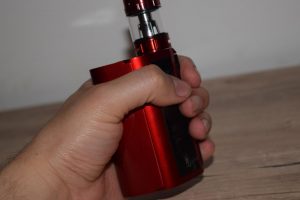12-Month Survey Concludes That Vape Shops May Play a Big Role in Helping Smokers Quit
A team of European researchers surveying changes in daily cigarette consumption in smokers making their first purchase at a brick and mortar vape shop found that advanced electronic cigarettes and expert support greatly increase chances of smoking cessation and cigarette reduction.
 Although still very popular with casual vapers and new ex-smokers looking for an alternative to their former dirty habit, cigalikes – electronic cigarettes that mimic the shape of analogs – are apparently not very effective at helping people quit smoking as second and third generation electronic cigarettes. Two randomized control studies investigating the success rate of cigalikes as quit-smoking aids produced some rather mediocre results: The ECLAT study carried out in Italy registered quit rates of between 4% – 8.7%, while the ASCEND study in New Zealand had quit rates of between 4% and 7.3%. These are just slightly better than the success rates of classic nicotine replacement therapy, like nicotine gum and patches, whereas a study in which eGo-style e-cigarettes were used reported a mind-blowing smoking cessation rate of 36%.
Although still very popular with casual vapers and new ex-smokers looking for an alternative to their former dirty habit, cigalikes – electronic cigarettes that mimic the shape of analogs – are apparently not very effective at helping people quit smoking as second and third generation electronic cigarettes. Two randomized control studies investigating the success rate of cigalikes as quit-smoking aids produced some rather mediocre results: The ECLAT study carried out in Italy registered quit rates of between 4% – 8.7%, while the ASCEND study in New Zealand had quit rates of between 4% and 7.3%. These are just slightly better than the success rates of classic nicotine replacement therapy, like nicotine gum and patches, whereas a study in which eGo-style e-cigarettes were used reported a mind-blowing smoking cessation rate of 36%.
Convinced that e-cigarettes can be even more successful at helping people quit smoking outside the rigid context of an experimental setting, Dr. Ricardo Polosa, of the University of Catania, teamed up with fellow scientists Pasquale Caponnetto, Fabio Cibella and Jaquez Le Houezec to survey a number of smokers making their first purchase at a specialized vape shop. Their theory was that the superior vaping hardware usually sold in such establishments, along with professional advice and regular technical support would yield a high success rate in smokers looking for an alternative.
Ten vape shop owners in the Italian city of Catania were contacted about taking part in the prospective 12-month survey. Three declined, but seven accepted to be involved in the research. Participating shops were bar or lounge types and displayed a wide range of nicotine in juices, large selection of flavors and hardware, including cigalikes, refillables and mods.
71 adult smokers (44 men and 27 women) making their first purchase at a vape shop were asked by professional retail staff to complete a form with their basic demographic and smoking history details, along with their nicotine dependence level, measured with a Fagerstrom Test of Nicotine Dependence (FTND) questionnaire. They were given detailed instructions on how to use, charge and refill their electronic cigarettes, and phone numbers were supplied for further technical assistance. Participants were encouraged to use the e-cigarettes to reduce the number of tobacco cigarettes smoked every day. Their cigarette consumption was noted at baseline and followed-up prospectively at 6 and 12 months.
Test subjects who reported sustained 50% reduction in the number of cig/day from baseline for the 30-day period prior to follow-up visit were classified as reducers, while those who reported sustained 80% reduction in the number of cig/day and sustained smoking abstinence from baseline for the 30-day period prior to follow-up visit were classified as heavy reducers and quitters, respectively. Those who didn’t meet the above criteria and those who didn’t check in for follow-up visits were classified as failures. Survey retention rate was high, with 49 of the 71 participants (69%) attending all their study visits and the final 12-month follow-up.
At the end of the 12 months, of the 71 participants enrolled in the survey, 29 (40.8%) could be classified as quitters, 18 (25.4%) as reducers, of which 11 (15.5%) had reduced their daily cigarette consumption by at least 80% from baseline (heavy reducers), and 24 (33.8%) were classified as failures. It’s important to note that 22 of the participants in this last category were didn’t turn up for follow-ups.
Combined smoking reduction and smoking abstinence was reported by 47 of the 71 subjects involved in the survey (66.2%), with the average number of cigarettes smoked per day decreasing from 24.7 at baseline to 2.2 at the 12-months follow-up. That is equivalent to an 89.1% reduction from baseline.
Researchers also observed that an increased number of participants switched from standard refillable e-cigarettes (their initial choice) to advanced mods (from 8.5% at baseline to 18.4% at 12 month). An overall decrease in the nicotine strength of the e-liquid used was also reported throughout the 12-month period. More users used a low (4–9 mg/mL) nicotine strength at 12 months, and, less users used a medium (12–18 mg/mL) nicotine strength at 12 month, compared to baseline.
Some changes in the preferred flavor used during the survey were noted, but researchers reported that most of the participants consistently preferred tobacco over other flavors.
“We have shown for the first time that combining availability of appealing e-vapor products for smoking substitution with professional advice from vape shops staff it is possible to achieve high and stable success rates. By promoting healthier life-style changes in smokers, vape shops may become valuable allies in the fight against smoking,” the scientists involved in the study concluded, adding that “larger studies are now needed to confirm these preliminary findings and to establish the importance of integrating these anti-smoking services into future tobacco control strategies.”
Source: International Journal of Environmental Research and Public Health
Photo: A. Currell/Flickr

















Yeay! Support your local vape shop!
Don’t try Big Tobacco cigalikes. We just don’t know what’s in them.